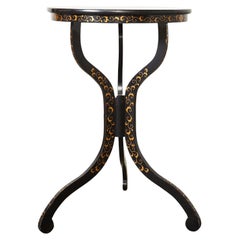Japonisme Lacquer Round Occasional Table Parcel Gilt Decoration
Recent Sales
20th Century Japanese Japonisme Side Tables
Wood
A Close Look at japonisme Furniture
In the late 19th and early 20th century, France developed an enduring passion for Japanese aesthetics and craftsmanship. Not only did this interpretation of Japanese culture — which became known as Japonisme — infuse fresh energy into French art and design, but it also radically transformed how Europeans, and subsequently the world, would come to understand visual culture.
Until 1853, Japan had been closely guarded against foreign visitors for over two centuries. However, American Commodore Matthew C. Perry sailed into Japan that year and initiated the first of its treaties with the United States and Europe, thereby opening its borders and giving the West its first-ever look at Japanese design.
For the next few decades, taken with Japonisme, sophisticated collectors in Paris, New York and elsewhere gorged themselves on lacquered screens, celadon ceramics and netsuke ornaments, along with artworks depicting various aspects of Japanese life. The East Asian country’s influence on Europe, particularly France, contributed to one of the most creatively prosperous periods in history, leaving an imprint on the Impressionist, Art Nouveau and Art Deco movements, and inspiring artists like Edgar Degas, Mary Cassatt, Vincent van Gogh as well as luxury houses such as Louis Vuitton and Hermès. Japonisme emerged at the time when the ornate Renaissance Revival style was the most prominent mode of decorating in Europe, and Japanese aesthetics seemed strikingly modern and elegant in comparison.
In addition to everyday practical objects from Japan, such as vases, tableware and decorative boxes, Japanese art, especially Japanese woodblock prints by masters of the ukiyo-e school, caught the eye of many artists — particularly those in the Art Nouveau poster community in 1880s Paris. The luscious organic colors associated with traditional Japanese design, motifs like cherry blossoms and carp and the vivid patterns found in woodblock prints, silks and more were adopted and appropriated by painters as well as ceramicists and those working in other fields of the decorative arts. Today, demand for Japanese lacquerware — furniture, trays, writing boxes, screens, incense burners — from the Edo period (1615–1868) and the late 19th century continues to be very strong among collectors.
Find a collection of antique Japonisme furniture and decorative objects on 1stDibs.
Finding the Right side-tables for You
While the range of styles and variety of materials have broadened over time, the priceless functionality of side tables has held true.
Antique and vintage side tables are an integral accent to our seating and provide additional, necessary storage in our homes. They can be a great foundation for that perfect focal piece of art that you want all your guests to see as you congregate for cocktails in the living room. Side tables are indeed ideal as a stage for your decorative objects or plants in your library or your study, and they are a practical space for the novel or stack of design magazines you keep close to your sofa.
Sure, owning a pair of side tables isn’t as imperative as having a coffee table in the common area, though most of us would struggle without them. Those made of metal, stone or wood are frequently featured in stylish interiors, and if you’re shopping for side tables, there are a couple of things to keep in mind.
With respect to the height of your side tables, a table that is as high as your lounge chair or the arm of your couch is best.
Some folks are understandably fussy about coherence in a living room area, but coherence doesn’t necessarily mean you can’t mix and match. Feel free to introduce minimalist mid-century modern wooden side tables designed by Paul McCobb alongside your contemporary metal coffee table. If you think it isn’t possible to pair a Hollywood Regency–style side table with a contemporary sofa, we’re here to tell you that it is. Even a leggy side table can balance a chunky sofa well. Try to keep a limited color palette in mind if you’re planning on mixing furniture styles and materials, and don’t be afraid to add a piece of abstract art to shake things up.
As far as the objects you’re planning to place on your side tables, if you have heavy items such as stone or sculptures to display, a fragile glass-top table would not be an ideal choice. Think about what material would best support your collectibles and go with that. If it’s a particularly small side table, along with a tall, sleek floor lamp, it can make for a great way to fill a corner of the room you wouldn’t otherwise easily be able to populate.
Whether you are looking for an antique 19th-century carved oak side table or a vintage rattan side table (because rattan never went away!), the collection on 1stDibs has you covered — find Art Deco side tables, bamboo side tables, travertine side tables and more today.
